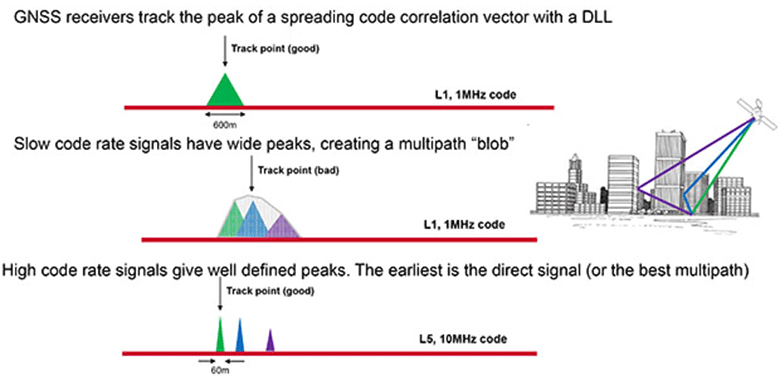In 2018, ultra-precise global navigation chips will appear in smartphones.
 Broadcom was pleased with the news about the development of the first dual-frequency GNSS receiver on the commercial market (L1 and L5) - the BCM47755 chip, which will be available to phone manufacturers in 2018. The first samples of the chip are ready, and now the company is preparing to start mass production.
Broadcom was pleased with the news about the development of the first dual-frequency GNSS receiver on the commercial market (L1 and L5) - the BCM47755 chip, which will be available to phone manufacturers in 2018. The first samples of the chip are ready, and now the company is preparing to start mass production.In today's receivers, the GPS signal reception accuracy is only 5 meters, which sometimes leads to awkward situations. For example, a GPS navigator in a car may incorrectly determine when you have already passed a turn and give an incorrect recommendation. New chips provide accuracy of 30 cm . Last but not least, these receivers will better catch the signal in difficult conditions, for example, on city streets in the vicinity of tall buildings. And finally, they consume half as much energy as the chips of the current generation.
BCM47755 is already included in the design of several models of smartphones intended for release in 2018, but Broadcom does not say which ones.
The receiver is able to simultaneously receive the following signals from global navigation systems (GNSS):
')
- GPS L1 C / A
- GLONASS L1
- BeiDou (BDS) B1
- QZSS L1
- Galileo (GAL) E1
- GPS L5
- Galileo E5a
- QZSS L5
In addition to GPS, both European Galileo, Japanese QZSS, and Russian GLONASS are supported.
How did you manage to improve the reception quality in the city? The fact is that all GPSS satellites, even the oldest generation, transmit the L1 signal, which contains the satellite coordinates, the exact time and the identifier. However, a new generation of satellites transmit not only L1, but also a more complex L5 signal at a different frequency, which differs from the standard L1 signal. Until recently, there were not enough L5 satellites in orbit to really use them in practice. But in 2015 and 2016, enough of these satellites were launched, and now there are about 30 of them, considering those that hang only over Japan and Australia. Still, now even in a narrow sky window in urban environments, you can finally see six or seven of these satellites, says a Broadcom spokesman . Therefore, now is the moment when you can launch a new generation receiver with increased accuracy, working with the L5 signal (the next generation satellites will provide centimeter accuracy at all).
The BCM47755 microcircuit is first fixed on the satellite by the L1 signal, and then it refines the calculated position by the L5 signal. The frequency of the latter is preferable for complex urban conditions, because this signal is less susceptible to distortion from multiple reflections.

In the city, the receiver simultaneously receives both a signal directly from the satellite and its reflections from buildings. That is, it receives several identical signals a little at different times, due to which a kind of signal blob is formed. The receiver is looking for a signal of maximum power to fix the reception time, but if the signals partially overlap each other, the calculations are not very accurate. So, the L5 signals are so short that it is almost unbelievable that the reflections are mixed with the original signal. The Broadcom chip additionally uses the carrier phase to further increase accuracy, IEEE Spectrum magazine explains .
In fact, there are already systems on the market that use the L5 signal and improved GNSS accuracy, but these are usually industrial systems, they are used, for example, in oil production. The BCM47755 chip will be the first mainstream microcircuit, which simultaneously accepts both L1 and L5.

The diagram shows the number of satellites of the new generation transmitting the L5 signal and schematically explains why the receiver should receive the signal at two frequencies L1 and L5
The new Broadcom chip has implemented several innovations, including a new architecture using big.LITTLE design from ARM. This is a dual-processor architecture, where one CPU has lower performance and lower power consumption, and the other processor is larger and more powerful. In this case, these are the Cortex M-0 and Cortex M-4 processors.
Additional information about BCM47755 will be discussed at the ION GNSS + 2017 conference, which will be held on September 27, 2017.
Source: https://habr.com/ru/post/370833/
All Articles